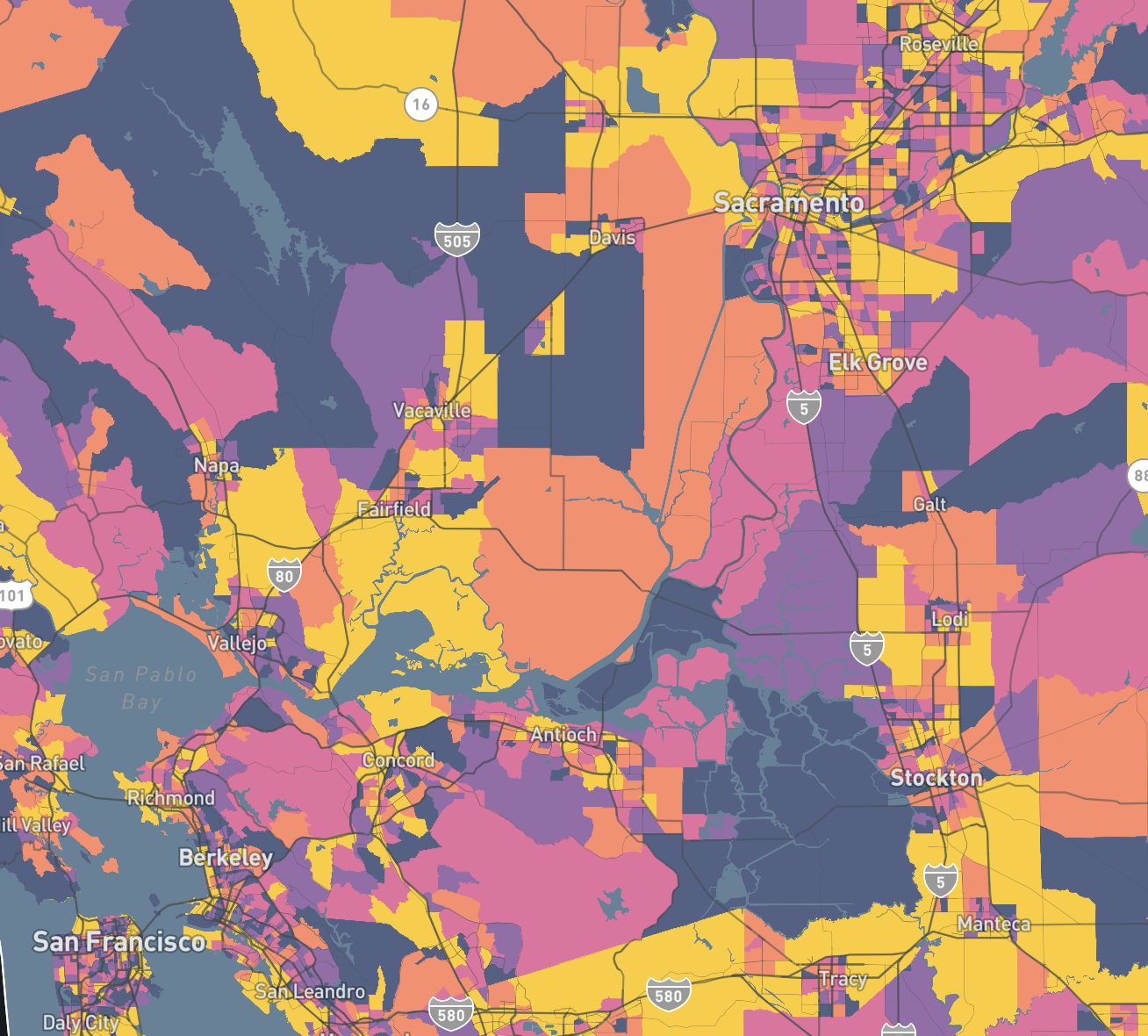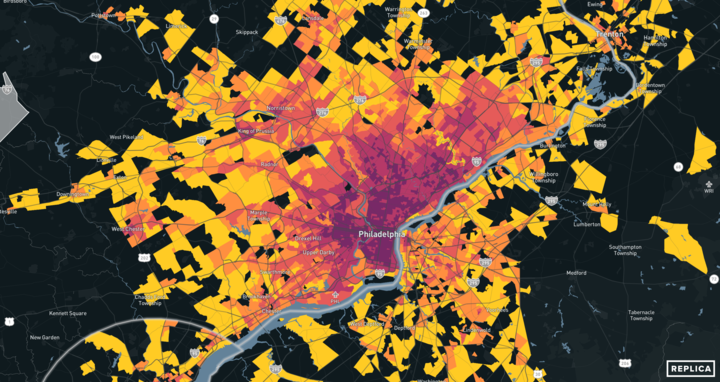This month, RMI released GridUp, a “a publicly accessible, state-of-the-art tool that helps utilities forecast when and where energy and power demands will materialize from vehicle electrification. The GridUp tool can forecast electric vehicle (EV) power needs at the census-block group level.”
Replica’s mobility insights are one of the core datasets powering the new tool.
We spoke with Ben Shapiro and Kirill Tchernyshyov from RMI to learn more about the new tool, what they hoped to achieve, and what public agencies should be thinking about when it comes to planning for vehicle electrification.
Thanks for joining us, Ben and Kirill. Can we start by you telling us a little bit about RMI and your roles?
Ben Shapiro: I’m Ben and part of the carbon free transportation team at RMI along with Kirill. We lead work at the intersection of the transportation and electric power sectors, specifically focused on charging infrastructure. Where do we need it? What sorts of policies and regulations do we need to be implementing? How do we enable a more rapid transition to electric vehicles?
Kirill Tchernyshyov: And I’m Kirill, a senior data scientist, who has been running a lot of the actual calculations for this tool.
So what is the genesis of GridUp?
BS: This project is the culmination of a lot of the analytical work our team has been doing to assess how much charging infrastructure is going to be needed to support EVs. There's a growing sense that EVs are real and coming, which is good. But we don't think that people currently have the tools and the data that they need to actually go and take action to make sure that we can accommodate all that new electricity load.
We hope GridUp will enable a lot of that good decision making, and be utilized by planning organizations, community-based organizations and all stakeholders influenced by these projects.
We want everyone to have a better sense of where we expect charging infrastructure will be needed and to have a voice in making the decisions around actually deploying it.
Can you talk us through the tool? What type of information should a city-planner expect to get from GridUp?
KT: The core information the tool provides is the amount of power used in different locations, and it makes projections out to 2035. We also provide a number of summaries such as power needed over time throughout the day, which is a direct input to the number of chargers needed.
We hope GridUp will enable a lot of that good decision making, and be utilized by planning organizations, community-based organizations and all stakeholders influenced by these projects.

Why is this critical right now?
KT: Well this type of disaggregate data is not readily available today on a nationwide scale.
BS: And it’s really important because not all areas are the same. In the past, electricity demand has grown more slowly, so utilities can estimate a bit better with longer time lines. For instance, when a developer builds a new building, the utility might have two years to expand capacity.
Contrast that with a local bakery that has a fleet of 15 delivery trucks. Right now, that is a small electricity customer. They have lights and refrigerators, but they don't have anything that's a particularly large electric load. But now they can go out (and in some places they have to go out based on new regulations) and buy electric trucks to replace their Fleet.
They can do that pretty quickly, and the utility might not even know any of this is happening, and it can cause a real issue. And the problem is more acute than that because those type of companies tend to aggregate in places like a warehouse district. And those are areas that probably have more insignificant electricity use today but where it could grow exponentially very, very quickly.
And that’s where we think the tool is really valuable. To be able to say: “Here is a big hot spot. We see it coming, in two years. Here's another large hotspot. You might have a little bit longer on that one, so plan accordingly…”
I think there is a lot of work we can do to look at charging infrastructure from an equity lens. And that’s one of the strengths of having Replica. The data is so rich and tied to so much demographic information, so it’s definitely an area we expect to explore further.
How does GridUp generate its estimates?
KT: At the core, what we are doing is estimating who is driving where, and how likely we think their vehicle is electric. That’s the really cool thing about using Replica. You essentially have these Trip Diaries, so you can understand what a vehicle is doing throughout the day and how much energy needs it accumulates and where it’s going to stop.
So with Replica, we can derive where geographically most of the charging will likely need to take place.

Does the tool incorporate the trip and trip-taker characteristics Replica offers?
KT: The trip purpose included in Replica data is core to the model. We also use the home location of the trip taker. You probably aren’t going to charge right around the corner from your house, you’d just go home, right?
Now that the tool is live, are there initial use cases or customers you’ve been most excited about?
KT: We’ve had a number of people plug it into their forecasts. One thing that is interesting has to do with the timing of charging. It’s been recognized for a while that there is a mismatch between existing demand and when you get a lot of solar / renewable energy. There is an excess of solar power in the middle of the day, and charging peaks tend to be in the evening. So naturally it suggests that we should be pushing for more workplace charging.
And GridUp, with its geographic granularity, allows you to look at it. The flexibility and speed of the tool really allows us to play around with different scenarios.
BS: I can also cite some of the questions and stats from GridUp we included in our press release.
- Which areas will see the largest amounts of EV growth, and what will drive that growth?
- Areas with a high concentration of medium- and heavy-duty electric truck activity are likely to see some of the largest new demands for electricity.
- The neighborhood of Cornell in southeast Atlanta, Georgia – where multiple logistics companies have distribution centers or freight depots – may see new loads of up to 7 MW, approximately as much power as the Atlanta Falcon’s Mercedes-Benz Stadium during an NFL game
- How much energy will be needed to support charging in a given area?
- For example, EV charging in Allegheny County, which contains Pittsburgh, will require the equivalent of almost 68,000 single family homes-worth of energy by 2035.
- For context, Pittsburgh currently has about 160,000 housing units.
- What kinds of charging locations will need to be built in specific areas?
- For example, GridUp demonstrates that Crown Heights, a relatively dense part of Brooklyn, mostly requires chargers in public locations and at multi-family homes, while Kew Gardens Hills, a less dense neighborhood of Queens, requires chargers at single-family homes and public locations.
What’s coming next? Is there a V2 in the works?
BS: I think there is a lot of work we can do to look at charging infrastructure from an equity lens. And that’s one of the strengths of having Replica. The data is so rich and tied to so much demographic information, so it’s definitely an area we expect to explore further.
We have an opportunity to really help answer a lot of the questions that will mitigate some of the massive uncertainty that exists in this system. We're excited about this and have generated a lot of excitement both internally and externally, so we appreciate all that Replica is doing to make a great product, and we want to continue talking about how we can collaborate together.
Us too. These are exactly the types of projects we built Replica to support. Thanks so much for taking the time to speak to us.








